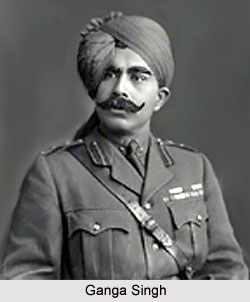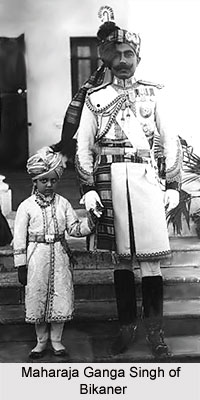 Ganga Singh, formally known as His Highness General Sir Maharaja Ganga Singh GCSI, GCIE, GCVO, GCStJ, GBE, KCB, was an eminent ruling Maharaja of the princely state of Bikaner, presently in Rajasthan, from the year 1888 to 1943. Singh is well known as a modern reformist visionary. He was the sole non-Anglo member in the British Imperial War Cabinet during the First World War. Maharaja Ganga Singh was born on 3rd October, 1880 as the youngest and third son of Maharaj Sri Lal Singh. Maharaja Shiromani Sri Dungar Singh Bahadur was his elder brother. After the death of his brother in the year 1887, Ganga Singh succeeded him on 16th December 1888. He was initially privately educated and later completed his studies from Mayo College, Ajmer, from 1889 to 1894. Later he received administrative training under the guidance of Thakur Saheb Lall Singhji from the year 1895 to 1898.
Ganga Singh, formally known as His Highness General Sir Maharaja Ganga Singh GCSI, GCIE, GCVO, GCStJ, GBE, KCB, was an eminent ruling Maharaja of the princely state of Bikaner, presently in Rajasthan, from the year 1888 to 1943. Singh is well known as a modern reformist visionary. He was the sole non-Anglo member in the British Imperial War Cabinet during the First World War. Maharaja Ganga Singh was born on 3rd October, 1880 as the youngest and third son of Maharaj Sri Lal Singh. Maharaja Shiromani Sri Dungar Singh Bahadur was his elder brother. After the death of his brother in the year 1887, Ganga Singh succeeded him on 16th December 1888. He was initially privately educated and later completed his studies from Mayo College, Ajmer, from 1889 to 1894. Later he received administrative training under the guidance of Thakur Saheb Lall Singhji from the year 1895 to 1898.
In 1898, Ganga Singh was sent to Deoli for military training and was also attached to the Deoli Regiment. It was considered as one of the finest Regiment in the country that was under the authority of Lieutenant Colonel Bell. Singh commanded the Bikaner Camel Corps during World War I and served in Palestine, Egypt and France.
Rule of Ganga Singh
General Sir Maharaja Ganga Singh General Sir Maharaja Ganga Singh, which was presided over by a Chief Judge and supported by to additional judges. In 1913, he also declared the establishment of a Representative Assembly. Later in 1922, he set up a High Court with a Chief Justice and two sub-judges by an edict. Ganga Singh-ji was the first prince in Rajputana to grant full charter of powers to a high court. The services of a saving bank were also made available for the general people and a Life Insurance and Endowment Assurance Scheme was incorporated for the betterment of the employees. The Maharaja of Bikaner later introduced the Sharda Act through a legislation which effectively stopped child marriages.
In 1918, he was given a personal gun salute of 19 guns and in the year 1921, a permanent local gun salute of 19 guns was granted to the prominent ruler. In 1902, he was the ADC to the Prince of Wales, as well as to George V in the year 1910. Ganga Singh became a member of the Central Recruiting Board of India in 1917 and represented the country at the Imperial War Conference in the same year, the Paris Peace Conference and the Imperial War Cabinet in 1919 and he was also appointed as the Chancellor of the Indian Chamber of Princes from1920 to 1926. In 1924, Singh represented India as a delegate at the 5th session of the League of Nations.
 His Highness General Sir Maharaja Ganga Singh served as patron of Sri Bharat Dharam Mahamandal and Benares Hindu University; and was a member of Indian Gymkhana Club and was the Vice President of Royal Colonial Institute and East India Association. He also became a member of the General Council of Mayo and Daly Colleges the Indian Society of Oriental Art, the Indian Army Temperance Association, the Bombay Natural History Society, the Indian Society London and he was the first Member of the Indian Red Cross Society.
His Highness General Sir Maharaja Ganga Singh served as patron of Sri Bharat Dharam Mahamandal and Benares Hindu University; and was a member of Indian Gymkhana Club and was the Vice President of Royal Colonial Institute and East India Association. He also became a member of the General Council of Mayo and Daly Colleges the Indian Society of Oriental Art, the Indian Army Temperance Association, the Bombay Natural History Society, the Indian Society London and he was the first Member of the Indian Red Cross Society.
Moreover Singh also built the Ganges Canal and motivated people to settle in the command area. He also faced the famine that occurred in 1899-1900 and successfully dealt with it. As a result, the Maharaja established an irrigation system as a permanent solution to the problem. Sir Ganga Singh also took efforts to develop the Sri Ganganagar city and its neighbouring area. He also built the Lalgarh Palace at Bikaner. Further more improved the state of railways and electricity network in the territory. The Maharaja of Bikaner introduced prison reforms and land reforms. He incorporated partial internal democracy like election to the municipalities and appointed a council of ministers for advice and support.
Sir Maharaja Ganga Singh inspired agriculturists and industrialists from other regions to commence new ventures in the princely state of Bikaner. In 1931, he constructed the existing temple above the Samadhi of Ramdev Pir at Ramdevra.
Personal Life of Ganga Singh
His Highness General Sir Maharaja Ganga Singh GCSI, GCIE, GCVO, GCStJ, GBE, KCB was married to Her Highness Maharani Vallabhkuver Sahiba of Pratapgarh in July 1897. Lter he was married to Her Highness Maharani Sri Bhatiyaniji Sahiba of Bikamkor. The royal couple had two daughters and four sons. Ganga Singh died at the age of 62 on 2 February 1943 in Bombay now Mumbai) after a rule of 56 years. He was succeeded by Sadul Singh, his son.
Titles of Ganga Singh
Ganga Singh held many titles and styles through out his reign, these are mentioned below-
* Maharaja Ganga Singh of Bikaner (1880- 1887)
* His Highness Maharajadhiraj Raj-Rajeshwar Narendra Shiromani Maharaja Shri Ganga Singh Bahadur, Maharaja of Bikaner (1887- 1898)
* 2nd Lieutenant His Highness Maharajadhiraj Raj-Rajeshwar Narendra Shiromani Maharaja Shri Ganga Singh Bahadur, Maharaja of Bikaner (1898- 1900)
* Major His Highness Maharajadhiraj Raj-Rajeshwar Narendra Shiromani Maharaja Shri Ganga Singh Bahadur, Maharaja of Bikaner, KIH (1900- 1901)
* Major His Highness Maharajadhiraj Raj-Rajeshwar Narendra Shiromani Maharaja Sir Ganga Singh Bahadur, Maharaja of Bikaner, KCIE, KIH (1901- 1904)
* Major His Highness Maharajadhiraj Raj-Rajeshwar Narendra Shiromani Maharaja Sir Ganga Singh Bahadur, Maharaja of Bikaner, KCSI, KCIE, KIH (1904- 1907)
* Major His Highness Maharajadhiraj Raj-Rajeshwar Narendra Shiromani Maharaja Sir Ganga Singh Bahadur, Maharaja of Bikaner, GCIE, KCSI, KIH (1907- 1909)
* Lieutenant-Colonel His Highness Maharajadhiraj Raj-Rajeshwar Narendra Shiromani Maharaja Sir Ganga Singh Bahadur, Maharaja of Bikaner, GCIE, KCSI, KIH (1909- 1910)
* Colonel His Highness Maharajadhiraj Raj-Rajeshwar Narendra Shiromani Maharaja Sir Ganga Singh Bahadur, Maharaja of Bikaner, GCIE, KCSI, KIH (1910- 1911)
* Colonel His Highness Maharajadhiraj Raj-Rajeshwar Narendra Shiromani Maharaja Sir Ganga Singh Bahadur, Maharaja of Bikaner, GCSI, GCIE, KIH (1911- 1917)
* Major-General His Highness Maharajadhiraj Raj-Rajeshwar Narendra Shiromani Maharaja Sir Ganga Singh Bahadur, Maharaja of Bikaner, GCSI, GCIE, KCB, KIH (1917- 1919)
* Major-General His Highness Maharajadhiraj Raj-Rajeshwar Narendra Shiromani Maharaja Sir Ganga Singh Bahadur, Maharaja of Bikaner, GCSI, GCIE, GCVO, KCB, KIH (1919- 1921)
* Major-General His Highness Maharajadhiraj Raj-Rajeshwar Narendra Shiromani Maharaja Sir Ganga Singh Bahadur, Maharaja of Bikaner, GCSI, GCIE, GCVO, GBE, KCB, KIH (1921- 1930)
* Lieutenant-General His Highness Maharajadhiraj Raj-Rajeshwar Narendra Shiromani Maharaja Sir Ganga Singh Bahadur, Maharaja of Bikaner, GCSI, GCIE, GCVO, GBE, KCB, KIH (1930- 1937)
* General His Highness Maharajadhiraj Raj-Rajeshwar Narendra Shiromani Maharaja Sir Ganga Singh Bahadur, Maharaja of Bikaner, GCSI, GCIE, GCVO, GBE, KCB, KIH (1937- 1943)
Honours of Ganga Singh
Maharaja Ganga Singh of Bikaner was honoured several times, such as-
* Kaiser-i-Hind, 1st Class- KIH (1900)
* Mentioned in Despatches (1901)
* China War Medal (1901)
* King Edward VII Coronation Medal (1902)
* Delhi Durbar Gold Medal (1903)
* Grand Cross of the Order of Philip the Magnanimous of Hesse (1903)
* Knight Grand Commander of the Order of the Indian Empire- GCIE (1907) and KCIE (1901)
* Honorary LL.D (1911)
* King George V Coronation Medal (1911)
* Knight Grand Commander of the Order of the Star of India- GCSI (1911) and KCSI (1904)
* Star 1914
* Bailiff Grand Cross of the Order of St John- GCStJ (1914)
* Mentioned in Despatches (1914)
* Honorary LL.D- Edinburgh (1917)
* Mentioned in Despatches (1918)
* Knight Commander of the Order of the Bath- KCB (1918)
* British War Medal (1918)
* Victory Medal (1918)
* Grand Cordon of the Order of the Nile of Egypt (1918)
* Honorary DCL (1919)
* Knight Grand Cross of the Royal Victorian Order- GCVO (1919)
* Knight Grand Cross of the Order of the British Empire- GBE; New Year Honours 1921
* Honorary LL.D- Benares Hindu University (1927)
* Honorary LL.D- Osmania University (1927)
* King George V Silver Jubilee Medal (1935)
* King George VI Coronation Medal (1937)
* Africa Star- 1942
* War Medal 1939 (1945)
* 1939- 1945 Star (1945)
* India Service Medal (1945)



















